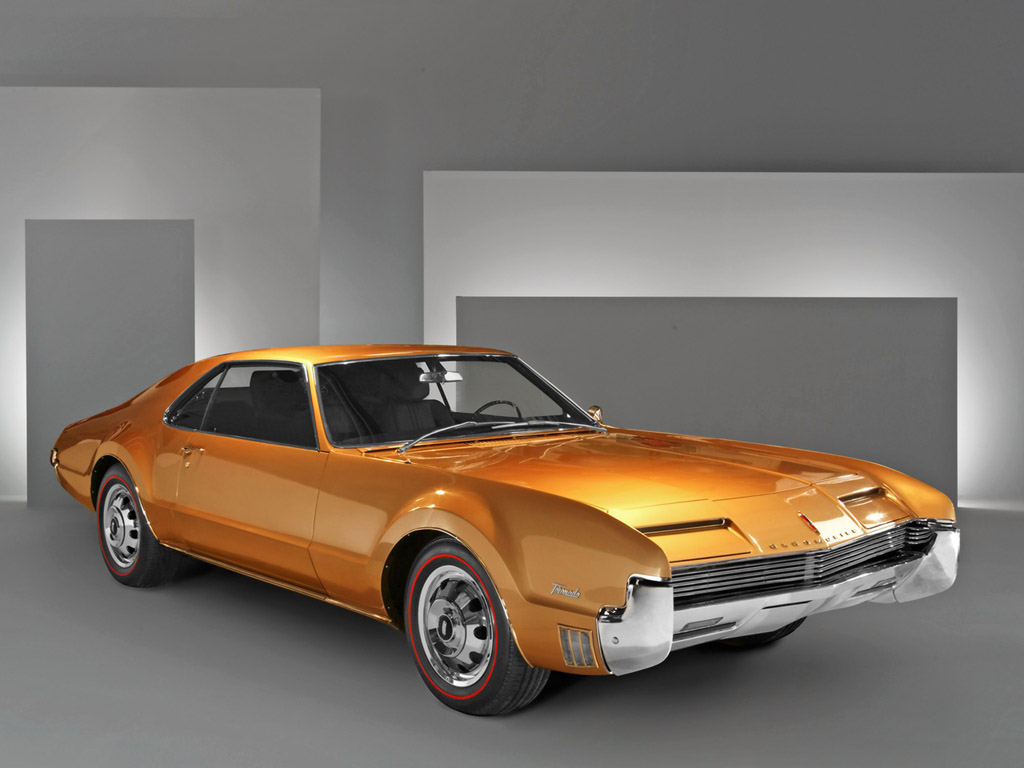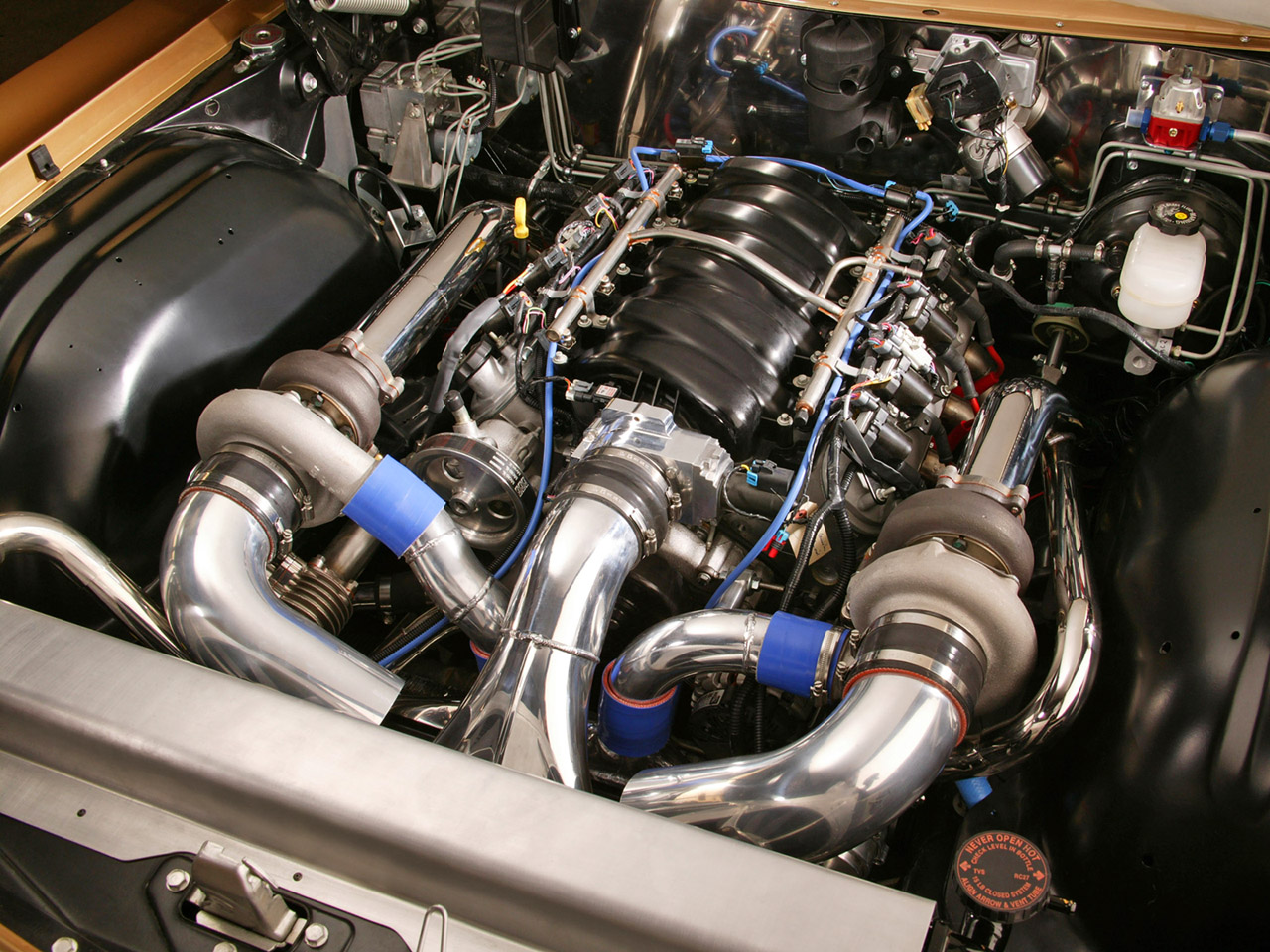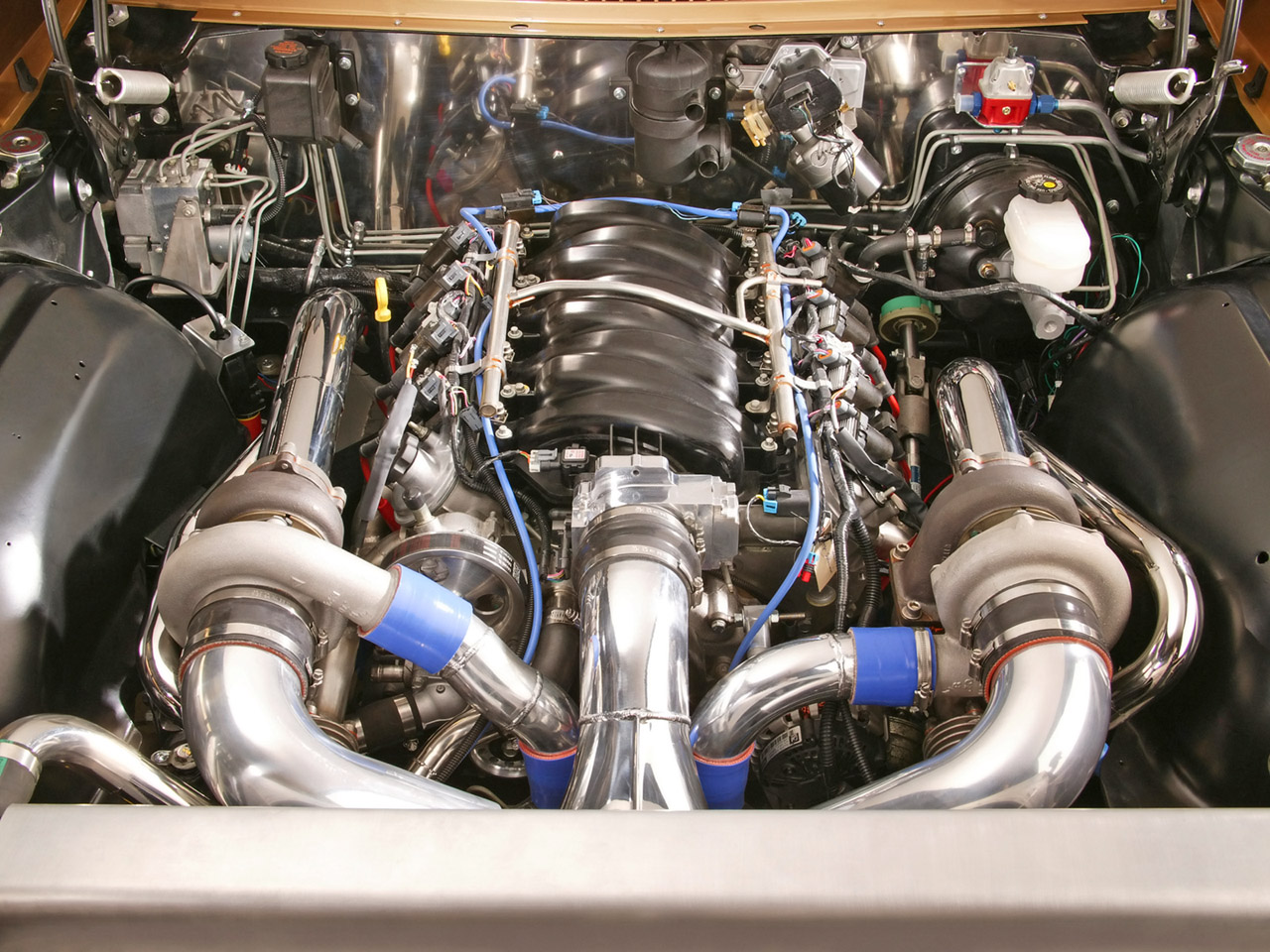1966 Oldsmobile Toronado of Jay Leno
|
Price |
-- |
Production |
-- | ||
|
Engine |
425 cubic inch V8 |
Weight |
-- | ||
|
Aspiration |
intercooled twin turbos |
Torque |
1000 lb-ft @ 4750 rpm | ||
|
HP |
1070 hp @ 6350 rpm |
HP/Weight |
-- | ||
|
HP/Liter |
153 hp per liter |
1/4 mile |
-- | ||
|
0-62 mph |
-- |
Top Speed |
-- |
(from GM Press
Release) Combining the vintage style of the 1966 Olds
Toronado with the contemporary punch of a 1,070-horsepower
twin-turbocharged V-8 GM Performance Parts prototype crate engine,
Jay Leno cruises Burbank , Calif. in a sophisticated blend of
classic style and cutting-edge technology.
Equipped with numerous parts under consideration by GM Performance
Parts (GMPP), the Toronado has a factory-look appearance, with
restored bodywork and a mostly stock interior – but under the sheet
metal lies a modified C5 Corvette chassis and suspension, along with
the sophisticated twin-turbocharged prototype crate engine and a
Corvette rear transaxle.
“This is a vintage American answer to expensive European grand
tourers,” Leno said. “There is an unmistakable character here that
exemplifies confident American car design – and it just happens to
be backed up by, oh, a thousand horsepower and the reflexes of a
Corvette.”
The car was built at Leno’s Big Dog Garage, in suburban Los Angeles
, under the direction of builder Bernard Juchli.
Leno was attracted to the Toronado for its distinctive styling and
historical significance – it was the first high-volume
front-wheel-drive car produced by GM. It was originally powered by a
425-cubic-inch V-8 that was connected to the front wheels via a
robust transaxle, a combination which pre-dated the industry’s
almost universal conversion to front-wheel drive by about 15 years.
The groundbreaking styling was the work of GM’s famed designer Bill
Mitchell, who styled an automobile that was lauded by critics when
new and has been remembered as one of the most important design
statements of the 1960s.
“It was a forward-looking car almost 40 years ago and its style
still looks contemporary today,” Leno said. “The prominent fender
flares are features you see on countless new vehicles, so the car
still has a smart, contemporary look when you apply current trends
like 17-inch wheels and tires – it’s a natural fit.”
Leno’s car, while still powered by a 425-cubic-inch engine, sends
power to the rear wheels by way of a C5 Corvette transaxle. In fact,
a C5 chassis was modified and grafted beneath the Toronado’s
bodywork. The Corvette’s sturdy hydroformed chassis was cut at the
firewall area and lengthened 14 inches to the rear, which pushed the
wheels into position within the car’s fenders. The basic suspension
– aluminum double wishbones with a transverse leaf spring, both in
the front and rear – was retained, although new springs and Bilstein
shocks were added to fine-tune the car’s handling and support the
Toronado’s heavier steel body.
The car sits on contemporary 17-inch Bridgestone Redline tires and
custom aluminum wheels designed to evoke the look of the original
hub-prominent versions. What wasn’t altered, however, was the car’s
bodywork or color. The original-look Trumpet Gold hue was reapplied
with a modern base coat/clear coat paint system from BASF and the
car’s body was restored to its factory-original appearance.
“The Toronado has a bold design – there was nothing like it then or
since, and we didn’t want to mess with Bill Mitchell’s original
styling,” Leno said. “Every piece of original trim has been restored
or replaced to make sure the car looks authentic.”
Two hairdryers, no waiting
Reaching the
1,000-horsepower threshold for the Toronado’s engine was achieved
with an intercooled twin-turbocharger system pumping 19 pounds of
boost into a GM Performance Parts prototype 425-cubic-inch
small-block crate engine. Developed in conjunction with GM
Performance Division, the engine uses a modified aluminum block and
cylinder heads from the Cadillac CTS-V racing program. They’ve been
reconfigured to work as a high-performance street engine – a must
for Leno, as he intends to use the Toronado as a daily driver.
Although not currently offered for sale by GM Performance Parts, the
high-performance 425 engine serves as a real-world evaluator for
potential new products.
“All the basic elements of this engine will soon be available in
either the GM Performance Parts catalog or elsewhere in the GM parts
system,” said Will Handzel, group manager, GM Performance Parts.
“Participating in projects such as Jay’s Toronado gives GMPP the
opportunity to ‘clinic’ high-performance combinations and evaluate
ideas we might not otherwise would have considered. This engine made
1,000 horses without too much trouble, and it already has us
thinking of future crate engine possibilities.”
A GM Performance-spec’d forged steel crankshaft and connecting rods
are used on the bottom end of the 425 engine, along with custom
forged aluminum pistons. When pushing up toward the CNC-ported
aluminum cylinder heads, the pistons deliver an 8.3:1 compression
ratio – a relatively low compression ratio required to ward off
detonation in a turbocharged engine. The cavernous heads channel the
huge volume of air generated by a pair of ball bearing-type
turbochargers to the combustion chambers. High-flow GM Racing fuel
injectors are used to match the airflow and a GM prototype camshaft
actuates the valves – the camshaft is a high-performance item that
may just reach production sooner than later.
High, prominent mounting of the turbochargers makes them impossible
to miss when the Toronado’s hood is raised. They generate airflow
that passes through a pair of intercoolers (mounted behind the
radiator) and through a pair of GM mass air meters, where the
pressurized air supply merges and enters the engine through a GM Gen
IV V-8 90-mm electronically-controlled throttle body and composite
intake manifold. A custom exhaust system was fabricated from
scratch-built, stainless steel headers and is routed through a
custom-fabricated stainless steel exhaust system.
In keeping with the car’s high-tech nature, as well as leveraging
the C5’s unique chassis layout, the Toronado’s engine is connected
to a beefed-up Hydra-Matic 4L60-E four-speed automatic via the
Corvette’s unique rear transaxle. The transmission actually is
attached to the rear axle rather than the engine; it also was
strengthened to handle the 425’s considerable torque. As the C5
chassis was lengthened by 14 inches, the driveshaft and torque tube
that link the engine and transmission required modification. Juchli
fabricated a new torque tube section, while a racing-style,
3.5-inch-diameter drivershaft was built by a local specialist.
Because the electronically controlled transmission doesn’t have a
traditional speedometer cable, a special converter – similar to
those used by many street rodders who adapt late-model,
electronically controlled transmissions to their vintage cars – is
used so the Toronado’s unique drum-style speedometer operates
accurately.
There’s another advantage to using the Corvette transaxle: it
creates better front-to-rear weight balance. The original Toronado’s
heavy front engine/transaxle combination placed a large mass over
the front wheels, rather than spreading it along the driveline and
out to a rear axle.
Basic black
From the ground up, Lear
customized the entire interior. Like the bodywork, the Toronado’s
all-black interior is mostly stock in appearance, right down to its
steering column-mounted automatic shifter. The car originally was
equipped with a front bench seat, but it was removed to make room
for a driveline tunnel required to make room for the chassis’ torque
tube. A pair of leather-covered seats was crafted to mimic the
design of available bucket seats. The rear seat also was re-covered
in leather and modified slightly to accommodate the driveline
tunnel.
A center console was crafted to fit between the bucket seats. It is
styled to appear vintage factory-original and serves to cover the
driveline tunnel. The dashboard is original, although a couple of
instruments have been added to more accurately monitor the
turbocharged engine’s operation.
Even the Toronado’s trunk was revamped. In it, a custom fuel cell is
fitted, as is a pair of high-volume electric fuel pump, a single
12-volt battery and a custom air conditioning system designed by
Vintage Air. And though it sounds full, the expansive, original
trunk swallows these necessities with room to spare.
“As a package, this Toronado has it all – classic styling and the
new technology of modern automobiles,” Leno said. “What this car
really needs is a road trip in Europe to demonstrate what an
American GT can really do.”
GM Accessories and GM Performance Parts are sold by Chevrolet,
Buick, Pontiac, Cadillac, GMC and HUMMER dealerships. For more
information visit www.goodwrench.com.
General Motors (NYSE: GM), the world’s largest vehicle manufacturer,
designs, builds, and markets cars and trucks worldwide, and has been
the global automotive sales leader since 1931. More information on
GM can be found at www.gm.com.
Engine specifications:
GMPP Prototype
425 ci Engine
Horsepower: 1070 @ 6350 rpm
Torque : 1000 lb-ft @ 4750 rpm
Max RPM Recommended: 7000 rpm
Compression Ratio: 8.3:1
Block: prototype/racing Gen IV block
Bore: 4.110”
Stroke: 4.000”
Crankshaft: prototype forged 4.000” stroke Gen III/IV
crankshaft
Connecting Rods: 6.125” forged connecting rods
Pistons: forged pistons
Piston Rings: Full stainless steel barrel type 1.2-mm
top ring, reverse twist cast taper cut 1.5-mm second ring, 3-mm
standard tension chrome face oil control ring
Camshaft: prototype hydraulic roller Gen III/IV
camshaft
Lifters: production Gen III/IV hydraulic roller lifters
Cylinder Heads: prototype/racing
Intake Valves: 56 mm
Exhaust Valves: 41 mm
Valve Springs: custom double valve springs
Spring Retainers: titanium
Rocker Arms: prototype/racing Gen IV rocker arms
Push Rods: prototype/racing
Intake Manifold: prototype/racing Gen IV intake manifold
Carburetor: NA
Rear Main Seal: production Gen III rear main seal
Windage Tray: production Gen III LS6 C5 Corvette
Damper: production Gen III LS6 C5 Corvette
Distributor: NA (production GM Gen III V-8 ignition coils)
Ignition Timing: 2004 C5 Corvette PCM controlled
Spark Plugs: 2005 C6 Corvette production spark plugs
Fuel: 93 octane / C16 for 1070 hp



